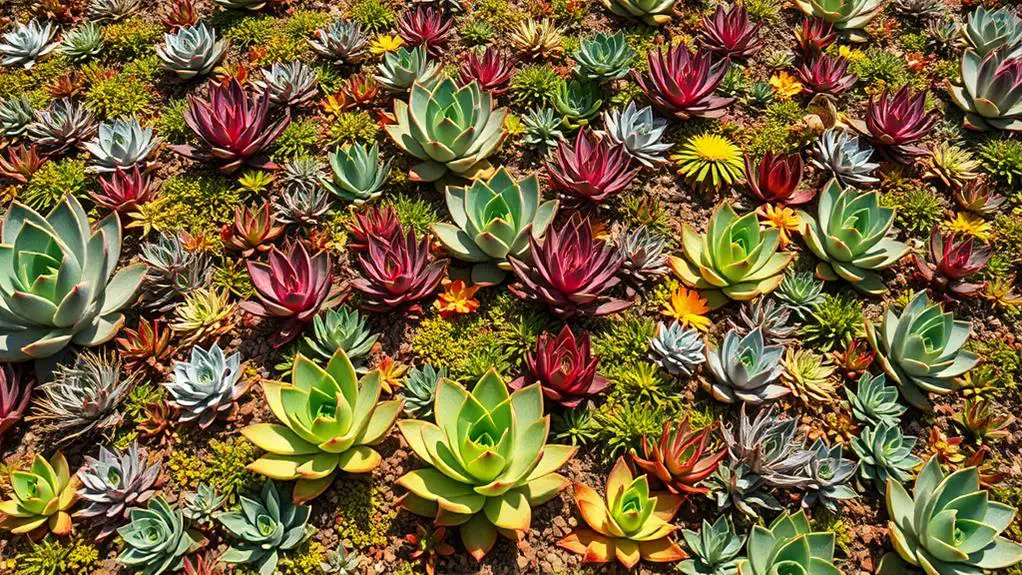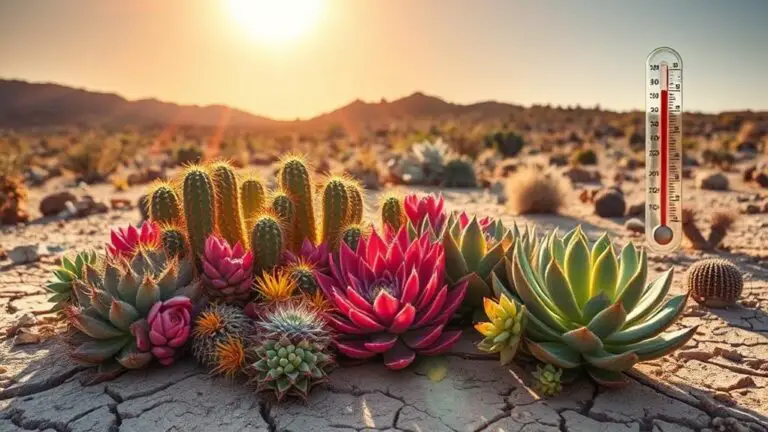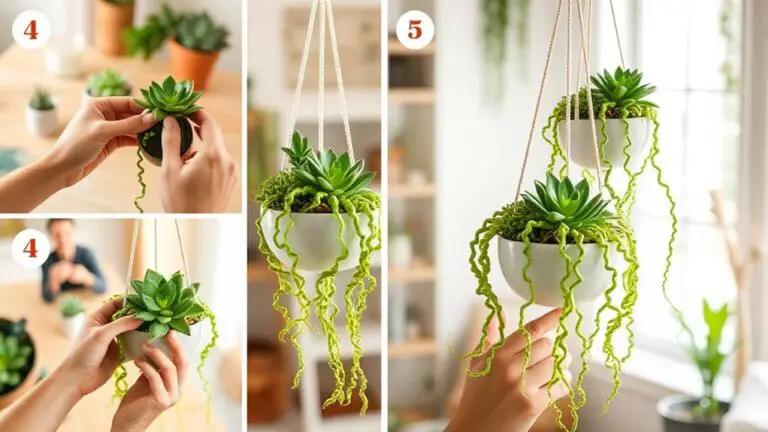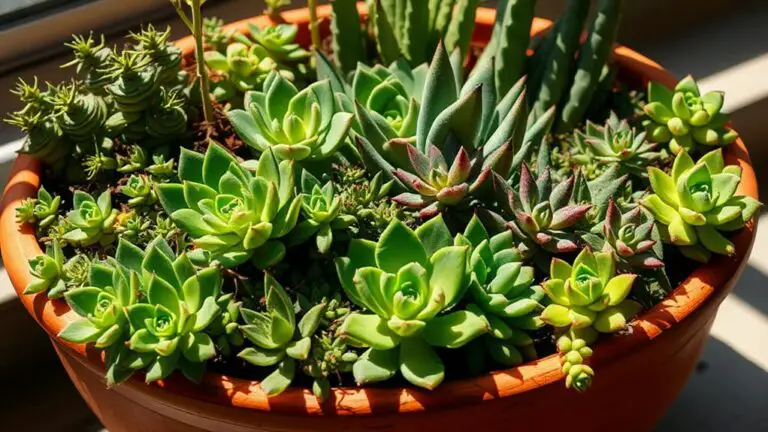7 Easy Steps to Use Succulents as Ground Cover Plants
Transforming your garden with succulents as ground cover plants is not only visually appealing but also practical. You'll start by understanding your hardiness zone to guarantee you choose the right varieties. Once you've got that covered, preparing the soil correctly is vital. Think you're ready to plant? Not so fast. The spacing and initial watering techniques play an essential role in setting up a thriving succulent garden. But that's just the beginning—there's more to explore, like mulching for moisture retention and regular maintenance tips. Curious about the next steps?
Know Your Hardiness Zone
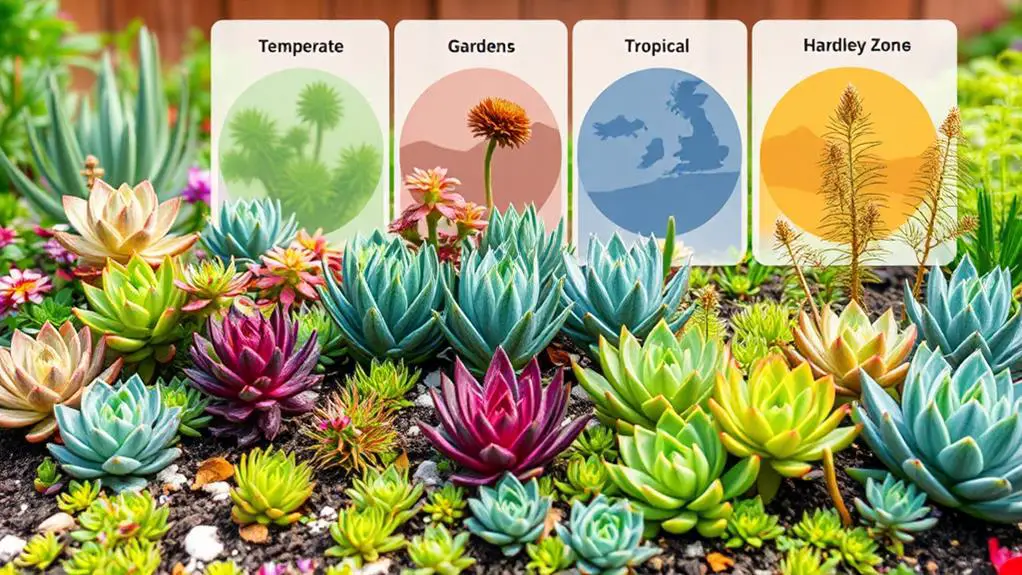
Understanding your hardiness zone is essential for selecting the right succulents for your garden. Your zone tells you which succulents will thrive in your specific climate.
Many succulent ground cover plants, like Caucasian stonecrop and hens and chicks, grow well in hardiness zones 3 to 8. If you're in a cooler area, these are great options.
Warmer zones, such as 7 to 12, are perfect for planting succulents like ghost plants and Echeveria.
To find your zone, use a hardiness zone map. This will guide you in choosing plants that can withstand your local weather.
By knowing your zone, you'll guarantee your succulents stay healthy and beautiful year-round.
Happy planting!
Prepare the Soil

Why is soil preparation so vital for your succulent garden? Succulents thrive in well-draining soil, so it's important to test soil drainage. Dig a trench and see if water pools or drains quickly. If your soil is heavy or clay-like, mix in sand or gravel to create a loose, aerated environment. Aim for a soil depth of 3 to 4 inches to support the shallow roots of succulents. Avoid organic mulch, which retains moisture, and use inorganic materials like pea gravel. Finally, check the soil pH, confirming it's between 6.0 and 7.5 for ideal growth.
| Step | Action | Reason |
|---|---|---|
| Test Drainage | Dig a trench, observe water behavior | Confirm well-draining soil |
| Amend Soil | Add sand or gravel | Enhance soil drainage |
| Soil Depth | Prepare soil to 3-4 inches | Support shallow root systems |
| Surface Cover | Use pea gravel or stones | Prevent moisture retention |
| Check pH | Confirm pH is 6.0-7.5 | Suitable for succulents |
Prepare the soil well, and you'll set the stage for a thriving succulent garden!
Choose Suitable Varieties
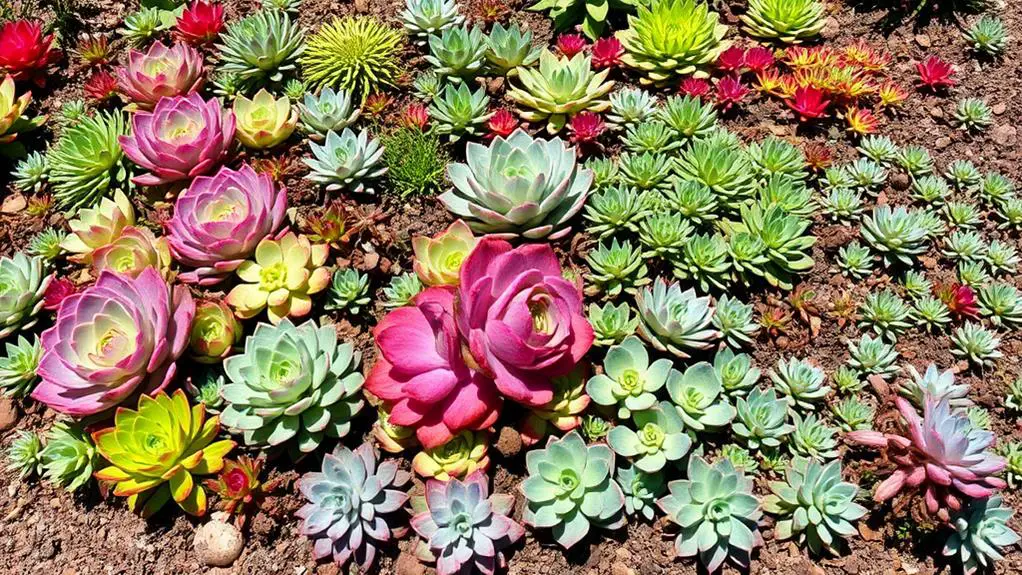
When choosing suitable succulent varieties, think about your climate and hardiness zone to guarantee they'll thrive in your garden.
For example, Creeping Sedum and Hens and Chicks work well in cooler regions, while Ice Plants and Ghost Plants are perfect for warmer areas.
Also, consider their growth habits and spacing; succulents like Caucasian Stonecrop can help control soil erosion and need less room to spread.
Climate and Hardiness Zones
Selecting the right succulents for your ground cover starts with knowing your climate and hardiness zone. Succulents thrive in arid and semi-arid climates, adapting well to hardiness zones 3 to 12.
If you live in northern climates, hardy varieties like Caucasian stonecrop and Hens and chicks, which grow in zones 3 to 8, are great choices. In southern areas, opt for drought-tolerant types such as Ghost plants and Echeveria, perfect for zones 7 to 11 and 9 to 12.
Coastal regions benefit from Creeping sedum, thriving in sandy soils with moderate rainfall in zones 4 to 9.
Understanding your specific hardiness zone guarantees you choose the right succulent varieties, promoting ideal growth and resilience in your garden.
Growth Habits and Spacing
Understanding the growth habits and spacing of succulents is essential for creating a lush, cohesive ground cover. When choosing varieties, consider creeping sedum for its ability to spread quickly and cover ground effectively.
Hens and chicks form dense mats with their rosette shape and thrive in zones 3 to 8. For trailing types like ice plants, plant them closer together to achieve a unified look. Upright species need more space for air circulation.
Blue spruce stonecrop, which grows up to 3 inches tall, is great for filling gaps. Always select varieties suited to your climate; ghost plants, for instance, thrive in zones 7 to 11. Proper spacing based on growth habits guarantees a vibrant and healthy ground cover.
Space and Plant Succulents
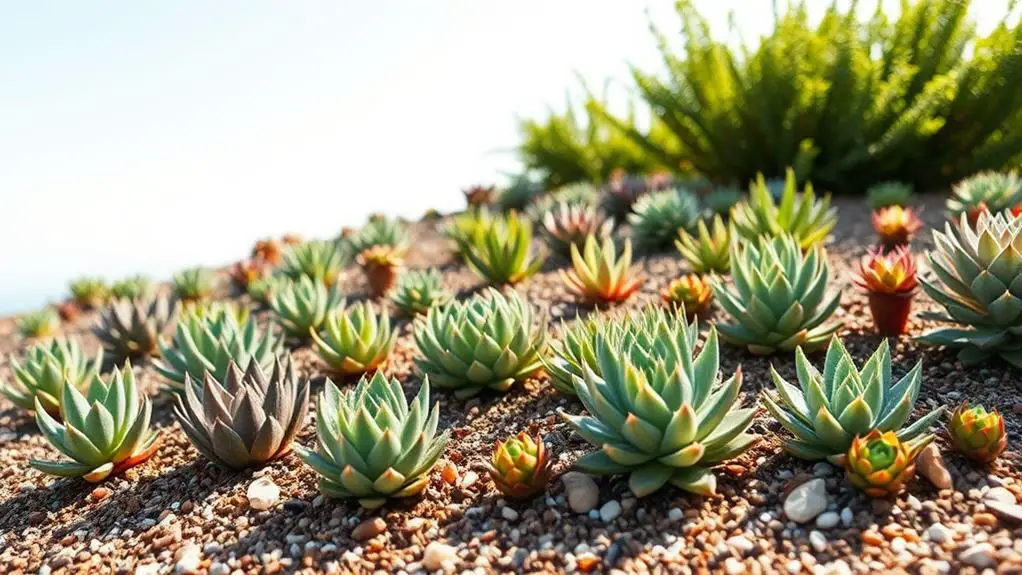
To create a thriving succulent ground cover, start by spacing your plants approximately 12 to 18 inches apart; this guarantees they've room to grow without becoming overcrowded.
When you space and plant succulents correctly, they'll spread beautifully over time. Make certain the area has well-drained soil by mixing in sand or gravel to prevent root rot.
Choose a sunny spot where your succulents can receive at least six hours of direct sunlight daily.
- Space plants 12 to 18 inches apart
- Use well-drained soil with sand or gravel
- Make certain at least six hours of direct sunlight
- Plant closer for quicker ground coverage
- Allow soil to dry out between waterings
These steps help your succulents thrive and spread effectively.
Water Properly
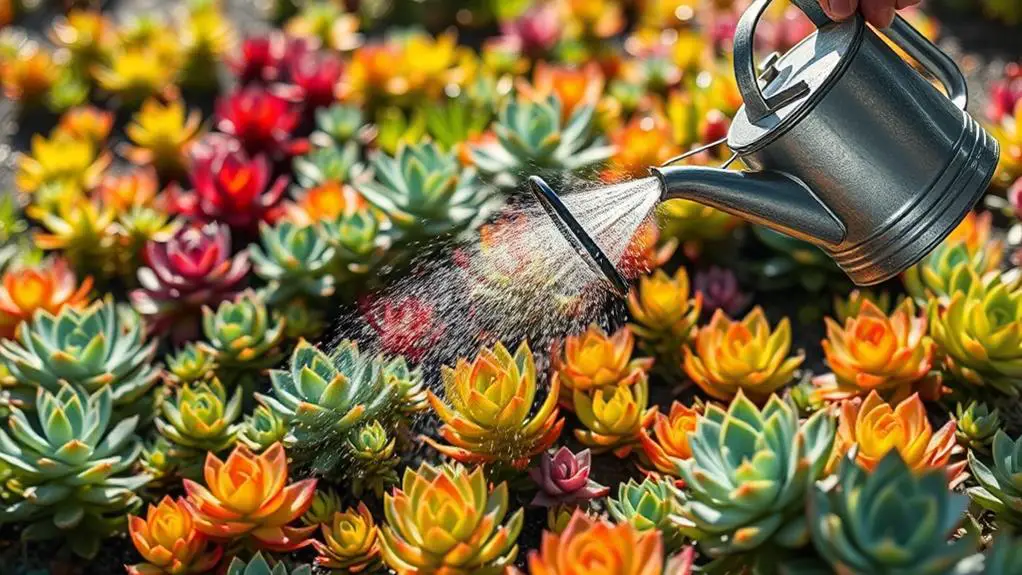
When watering succulents, it's essential to find the right balance.
Start by watering lightly and frequently to help young plants establish strong roots, then adjust based on the season and climate.
Always let the soil dry out completely between watering to prevent root rot and use a well-draining soil mix for the best results.
Optimal Watering Schedule
A crucial aspect of maintaining healthy succulents as ground cover is to water them sparingly, allowing the soil to dry out completely between waterings. This ideal watering schedule helps prevent root rot and guarantees well-draining soil conditions.
Start by lightly and frequently watering new plants, then shift to deeper watering as they mature. Adjust watering frequency with the seasons—more during spring and summer, less in winter. Use the "soak and dry" method to thoroughly saturate the soil without leaving it soggy. Tailor your schedule based on environmental factors like temperature and humidity.
Here's a quick guide:
- Light, frequent watering for new plants
- Deeper watering as plants mature
- More water in spring/summer, less in winter
- "Soak and dry" method
- Adjust for temperature and humidity
Soil Moisture Levels
Maintaining proper soil moisture levels is critical for the health of your succulents. Succulents thrive best in well-draining soil, so amend heavy soils with sand or gravel to achieve ideal moisture levels.
During the establishment phase, water your succulents lightly and frequently, letting the top inch of soil dry out between sessions. Once established, they prefer deep watering followed by extended dry periods.
Monitor the soil moisture by checking if it's dry about an inch deep before watering again. Be cautious not to overwater, as succulents can suffer from fungal diseases in consistently moist soil.
Drought Tolerance Tips
Achieving the right soil moisture is just one part of the puzzle; proper watering techniques are equally important for maintaining healthy succulents.
To help your plants thrive, follow these drought tolerance tips. Water deeply but infrequently, allowing the soil to dry out completely between waterings. During their active growth season, succulents need more water, but in winter, water lightly as they enter dormancy.
Always check the top few inches of soil for dryness before watering, and use well-draining soil to avoid root rot. In hot climates, provide some afternoon shade to reduce water loss.
- Water deeply yet infrequently
- Check soil moisture before watering
- Use well-draining soil
- Adjust watering based on seasons
- Provide shade in intense sunlight
Mulch and Protect
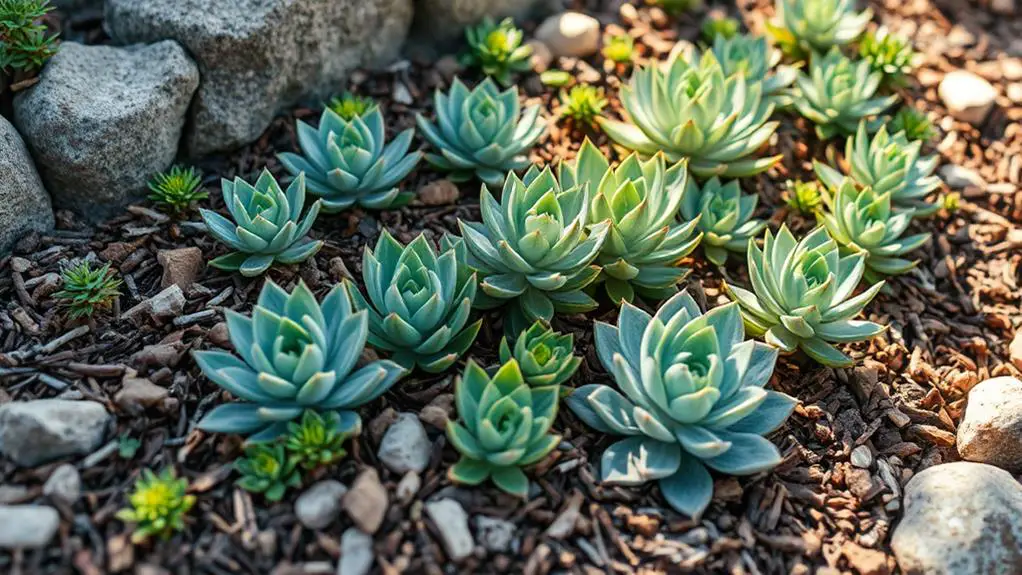
When it comes to mulching and protecting your succulent ground cover, opt for inorganic mulch like pea gravel or small stones to enhance drainage and avoid fungal issues.
This type of mulch helps regulate soil temperature and minimizes weeds without smothering your succulents. After planting, apply a light layer of inorganic mulch.
Regularly inspect the mulch to guarantee it remains effective; replenish or replace it as needed. In winter, add an extra layer to insulate roots and prevent frost damage.
For areas with high foot traffic, use decorative stones or gravel that can withstand movement while protecting your plants.
Maintain and Prune

Proper care and upkeep are essential to ensuring your succulent ground cover remains vibrant and healthy. Start by regularly removing dead leaves and spent flowers to maintain a tidy appearance and encourage new growth.
Light pruning can help shape the plants and promote denser growth, but keep it minimal since succulents don't need much. Watch for any signs of pests and diseases, and quickly remove affected areas to prevent them from spreading.
Here are key tips to follow:
- Remove dead leaves and spent flowers regularly.
- Prune lightly to shape and promote growth.
- Monitor and remove any pests and diseases promptly.
- Apply a light liquid fertilizer in early spring.
- Adjust watering based on the season.
These steps will help you maintain a healthy and appealing succulent ground cover.
Frequently Asked Questions
Can I Plant Succulents Directly in the Ground?
Yes, you can plant succulents directly in the ground. Just make certain the soil is well-draining by adding sand or gravel. Pick a sunny spot, space them closely, and water lightly at first. They'll thrive!
How Do You Use Succulents in Landscaping?
You can use succulents in landscaping by selecting drought-tolerant varieties, ensuring well-drained soil, and spacing them for quick coverage. Water sparingly, and use inorganic mulch to retain moisture and minimize weeds and pests.
Can You Put Succulent Cuttings Straight Into Soil?
Yes, you can put succulent cuttings straight into well-draining soil. Let the cuttings dry for a few days first to prevent rot. Plant them shallowly, water lightly, and they'll establish roots in a few weeks.
How Do You Arrange Succulents in the Ground?
Arrange succulents by spacing them according to their growth habits. Place trailing varieties at the edges and upright types in the center. Group them in clusters for a dense cover, ensuring each plant gets enough sunlight.
Conclusion
You've got this! By following these steps, you'll create a beautiful, low-maintenance succulent ground cover. Just remember to know your hardiness zone, prepare well-draining soil, and choose the right varieties. Space your plants properly, water them carefully, and don't forget to mulch and protect them. Regular maintenance, like pruning and pest monitoring, will keep your garden thriving. With a little effort, your garden will be a stunning and easy-to-care-for oasis. Happy gardening!

